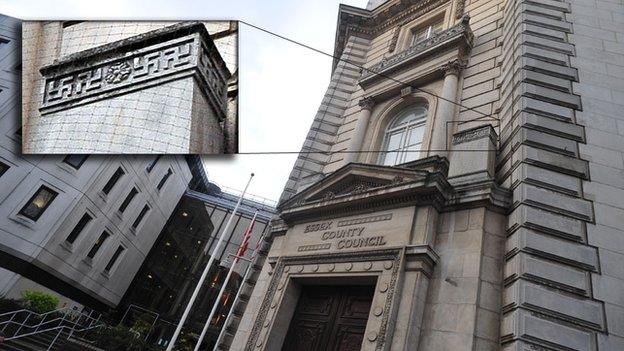Essex County Council HQ swastikas should be removed says UKIP group
- Published

Jamie Huntman, leader of UKIP at Essex County Council, said removing the swastikas should be "very simple" to do
An urgent meeting has been called for over the future of carved swastikas on Essex County Council's HQ building.
Earlier this week, it was reported the markings on County Hall had been deemed "potentially upsetting".
The carvings on Chelmsford's County Hall, built between 1928 and 1939, were made shortly before World War Two.
Although the swastika is an ancient peace symbol, the council's UKIP group said most would associate it with Nazism and wants the carvings removed.
The county council said the swastikas were included in designs finalised in 1926 and removing them would be costly and require special permission.
The issue came to light after a Freedom of Information request was lodged with the council asking why the design "was still commissioned given the symbol's negative connotations".

This section of Essex County Council's headquarters was finished in 1939, the year Britain and Nazi Germany went to war
The person requesting the information, who has not been named, said the timing of the swastika symbols "struck me as strange seeing as the Nazi party formed in 1933 and by March 1938 were beginning an invasion into Austria.
"It's potentially offensive and upsetting to those that lost loved ones in the war or those that fought for their country," the person wrote in their request.
Jamie Huntman, leader of the UKIP group on the county council, said he has requested an "extraordinary meeting" with the authority's chief executive Joanna Killian.
Mr Huntman said removing the symbols would be "very simple".
He said although he understood the swastika was an ancient Hindu symbol of peace, County Hall was "not a Hindu temple".
"I've got relatives who fought in the war," he said. "I find it offensive. I am very proud of being English and British and what our young men fought for, and against.
"Whenever I see that symbol, the first thing I - and I believe most people - think of is Nazism."
But a spokesman for the county council: "Plans for the County Hall building were drawn up from 1908 and our records show that the architect was ordered to finalise the plans in October 1926.
"Given similar designs are featured on a number of other public buildings of similar age across the world, including churches and universities, it is important that the symbol is seen in its architectural context.
"This part of County Hall has Grade II listed status and any changes to this frontage could be extremely costly to the public purse and would have to be approved by English Heritage."
- Published25 February 2014
- Published21 November 2013
- Published27 October 2013
- Published25 July 2012